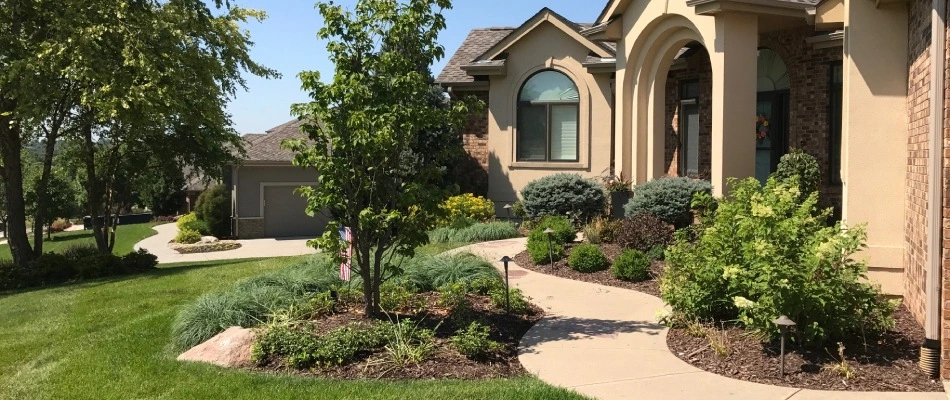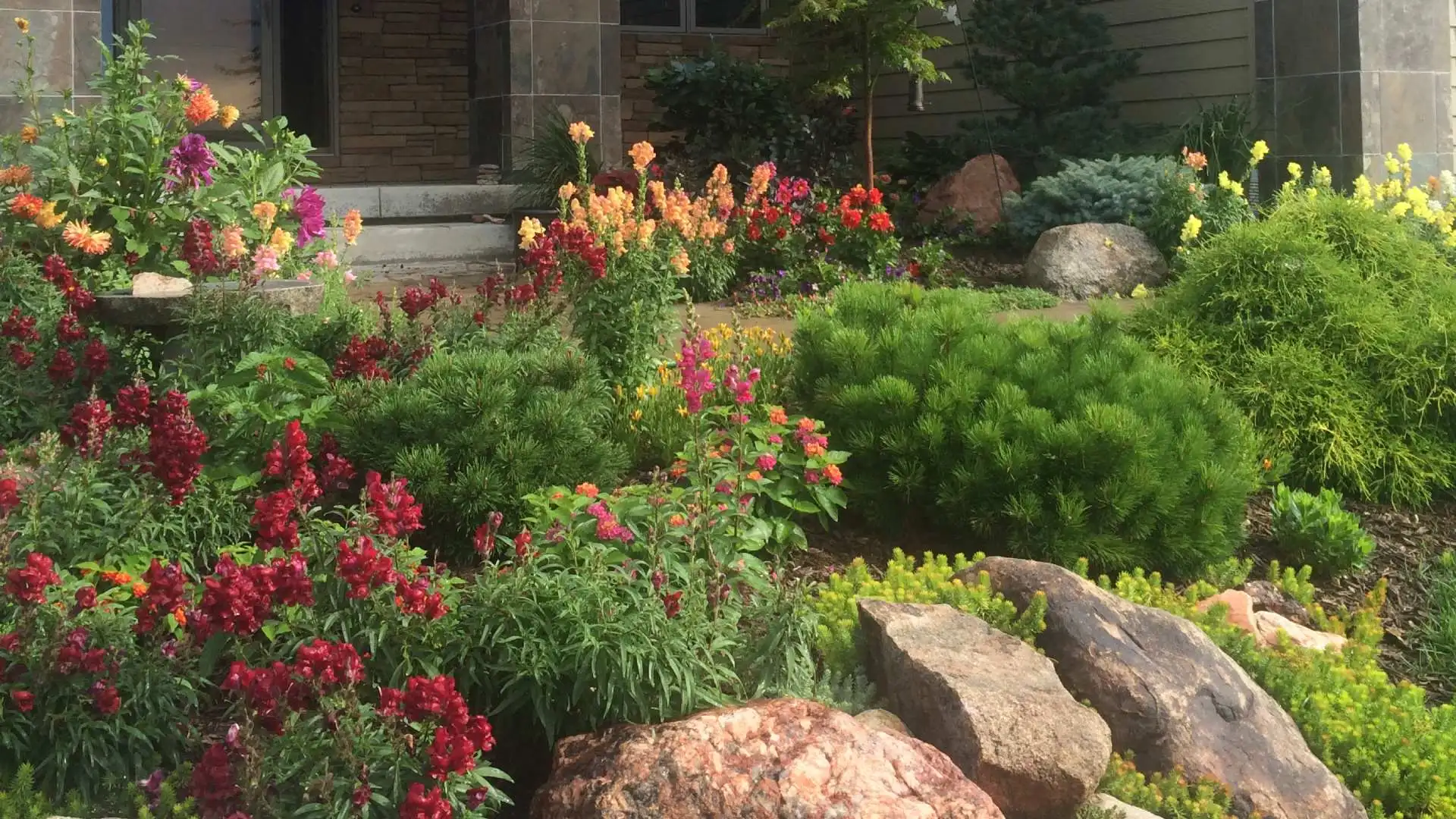When it comes to lawn and landscape maintenance, there are so many tips and guidelines to remember. Sometimes it can be a little overwhelming, especially if you're unfamiliar with the subject. Below is a compilation of commonly asked questions and answers to help you care for and maintain your lawn and landscape in Nebraska.
Winter Care Tips
Winter in Nebraska can be quite tough on your landscape and hardscapes. Below is a list of commonly asked questions and answers that can help you prepare your landscape for the winter.
- Can I get away with leaving debris in my landscape beds and around my hardscapes over the winter or should I remove it?
- Remove debris to create good airflow around your plants. If left alone, they have the potential to bring fungus and disease to your plants. You'll also want to remove debris from your hardscape features because leaves can release tannins that can stain concrete surfaces.
- What type of plants should I prune in preparation for the winter season?
- You should prune shrubs and trees when the sap stops flowing. Avoid pruning spring-flowering plants.
- Are anti-desiccants really necessary?
- Yes, you want to spray anti-desiccant to prevent moisture loss on plants like boxwoods, yews, and spruce.
- What type of deicing solution should I use on my pavers?
- Use a calcium chloride solution instead of a sodium chloride solution. It's less damaging to concrete pavers.
- How does mulch protect my plants from the winter cold?
- Mulch will protect the base of sensitive plants from extreme cold.
Spring Cleanup
Once winter is over, it's time to prep your landscape for the warmer spring season. Here is some information to help you get started on a spring cleanup project.
- What are some landscape maintenance tasks I should be doing this spring?
- Clean out your landscape beds, prune your landscape plants, clean up your hardscapes, and add mulch to your landscape beds.
- What type of fertilizer is best for my plants in the spring?
- Use a slow-release fertilizer around the base of your plants and in your grass to provide them with a constant supply of nutrients.
Fall Cleanup
Fall is a great time to do maintenance on your landscape to prepare it for winter. Below you'll find some information on fall cleanups to help you get started.
- What are some landscape maintenance tasks I should be doing this fall?
- Clean out your landscape beds, prune your landscape plants, winterize your water features, apply anti-desiccant, clean your hardscapes, and cut back any perennials and grasses.
- How can I prepare my hardscapes for winter?
- Wash your patio furniture and hose down paths, patios, retaining walls, and fire pits. Drain your garden hoses and store them for the winter. Cover your furniture as needed and store them too.
Pondless Water Features
A pondless water feature is a recirculating water feature that functions by pumping water from an underground reservoir to the top of a rock or rock formation. Below are some common maintenance tips for your pondless water feature.
- Do I need to remove my water feature pump before each winter season?
- No, you do not need to remove your water feature pump before each winter season. Just unplug the water feature pump from the electrical outlet it's plugged into.
- How do I start up my water feature pump after the winter season?
- Start by removing fallen leaves and debris on top of the water feature basin. Then plug in the water feature pump. Afterward, open up the quick discharge valve at the top of the sump well and drain off the water completely from the pondless reservoir. Once drained, close the valve and fill your reservoir with fresh water from the hose spigot on your home.
- How do I get rid of string algae that formed on the stones of my water feature?
- Either remove string algae by hand or treat with household bleach. If you don't want to use bleach, then you can use a mix of white vinegar and water instead.
- How do I prevent my water feature from losing water?
- A pondless water feature is bound to lose water. If it's too hot, the water will evaporate. Water is also lost when splashing occurs. To minimize splashes, adjust the valve that's going to the rock formation. High winds also contribute to water features losing water, so it's best to not run your water feature during periods when the wind is strong.
New Sod Tips
Sodding your lawn is a great way to quickly get a new lawn. However, there are some important things you need to know when caring for your newly sodded lawn.
- How much water should be added to my lawn after new sod is installed?
- Sod should be watered 3-4 times per day for 3 weeks or until it is established.
- How long do I have to wait to mow my lawn after installing sod?
- Do not mow your sod for 3 weeks. After 3 weeks have passed, mow once a week on the highest setting on your mower.
- Should I apply fertilizer to my new sod?
- Do not apply any fertilizer to your sod for 4 weeks. Applying fertilizer too early can burn your sod.
To ensure you don't cause any damage to your new sod, try and stay off of it for at least 2 weeks so that it can establish strong roots.
How to Water Your Landscape
Watering your landscape is important, especially when you have new plants that need water at the root level to become established. Below are a few watering tips to help you when watering your landscape plants. To learn more, read this blog that goes over watering guidelines!
- When is the best time of the day to water your landscape?
- It's best to water during the early morning hours. This prevents your water from being evaporated during the day when it gets hotter.
- Is it better to water the foliage or the roots of my plants?
- It's better to water the roots of your plants. Wet foliage encourages disease.
- Why is it better to water my plants infrequently with deep moisture rather than frequently with shallow moisture?
- The water needs to reach the depths of their rootlets. Otherwise, you risk your plants rooting near the surface. This could lead to dependence on frequent watering and up-rooting during storms.
Fire Features
Fire features like fire pits and outdoor fireplaces make great additions to any landscape, but it's important to understand how they work for safety reasons. Here are some common guidelines to help you operate and maintain your outdoor fire features.
- How do I start my fire feature?
- Insert the key into the valve on the side of the fire feature to start it and turn it counterclockwise. You should then hear or smell gas coming out. After waiting a few seconds, use a lighter towards the edge of the fire feature to light it.
- How do I turn my fire feature off?
- Turn the key in the valve clockwise until you can't turn it anymore. This will shut the valve. It may take a couple of seconds for the flame to fade away entirely.
- Can I leave the key in my fire feature when I am not using it?
- It's not recommended because the gas could be turned on by anybody by accident.
- What is the best lighter to use for the fire feature?
- A long reach lighter is recommended.
- Do I need to put a cover on my fire feature?
- It's not necessary. However, if your fire feature is filled with fire glass, then you should put a cover on it if it tends to get windy.
- What should I do if I smell gas by my fire feature even though the valve is closed?
- Leave the area and call your gas provider immediately.
- I turn the key but do not hear or smell any gas coming out, what should I do?
- Turn the key off and check to make sure the valve is in the open position at your gas meter. If it's on and there's still no gas at the fire feature, we suggest scheduling a service visit.
If you need any assistance with your lawn and landscape projects, then give us a call today to schedule one of our services!

At UPL, we offer a wide variety of lawn and landscape services to assist you with whatever task or project you need to get done. We service commercial, HOA, and residential properties in Omaha, NE, and surrounding cities like Elkhorn and Gretna. Call us today at (402) 590-2040 to schedule or sign up for one of our many lawn and landscape services!







Comments (0)
Thanks for your comment!
Thanks for your feedback! Your comments have been successfully submitted! Please note, all comments require admin approval prior to display.
Error submitting comment!
There is a problem with your comment, please see below and try again.